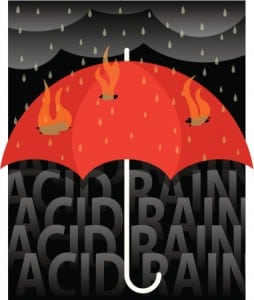 The Problem with Acid:
The Problem with Acid:
The pH scale measures two extremes: acid and alkaline. They are equal in both their opposition and in their relevance to the cleaning industry. Recent environmental concerns, however, and subsequent discussions, have assigned very different values to these two extremes. While alkaline is generally ignored, playing the role of the less controversial and apathetic anti-hero, acid is the vile drooling villain most often blamed for the darkness now fallen over our once Green kingdom.
Perhaps the problem with acid is rooted in the term itself. The American counterculture of the 1960’s associated the term “acid” with the trippy, altered state of consciousness experienced while using LSD.[1] Acid, as a term, was no longer used to express hydrogen ion concentrations found within natural or manufactured compounds;[2] it became less a term and more a label. It seems, in fact, from the moment when Albert Hofmann accidentally ingested lysergic acid diethylamide (LSD) in 1943, acid has become a social label with generally negative connotations. Suddenly, the world was introduced to terms like dropping acid, acid rock, and acid washed jeans. More recently, and as it aligns with environmental concerns, acid rain has entered our global vernacular.
Unfortunately for acid, this new label has fostered debate. Physical and ethical implications of acid use are discussed, and moral judgments are pronounced. The acid label even comes with a flesh eating picture courtesy of the Department of Transportation’s (DOT) regulations.[3] Chemicals that contain a particularly high level of acid, therefore, such as Hydrofluoric acid, generate the most caustic environmental and moral debates.[4]
Acid Science:
Let’s play a game. I’ll move my finger along the acid side of the pH scale, and you tell me when I’ve reached the point you will no longer ingest any product that has an associated pH value. I’m guessing you will stop me right around 5…maybe as high as 4. We tend to think “danger” as those red colors get brighter. But did you know Coca-Cola Classic contains Phosphoric acid and has a pH value of 2.5? [5]
Acid cleaners are used to remove various types of discoloration and tarnish from metals and masonry. They are used for both household cleaning tasks and more industrial tasks such as cleaning brick or concrete. Acid dissolves hard water spots on shower walls, and removes rust stains from porcelain.[6] Hydrofluoric acid is used to brighten aluminum. Hydrochloric acid is commonly used in nasal sprays. Eye drops contain Boric acid.
Acid Safety and Regulations:
Consider the use of Aluminum Brightener which lists Hydrofluoric acid as one of the ingredients.[7] The pH value is less than 1. Is it safe to use? That is a fair question.
The University of Chicago has a published policy for employees who work with Hydrofluoric acid (HF).[8] Tufts University has a standard operating procedure created to educate the Tufts community on the proper use of Hydrofluoric acid.[9] The University of Colorado has written requirements for use of Hydrofluoric acid.[10] Why would such well-known institutions for higher level education have these documents available? As stated within each document, it is written for those employees who work with or use Hydrofluoric acid. Is it safe for them to use? It appears they’ve already answered the question: yes, when used correctly.
Using acid products, like most things in life, requires proper education, preparation, and application. Wear Personal Protective Equipment. Read the Material Safety Data Sheets. Use the right amount of product. Understand the intended environment for the product in question. Follow all Federal and State regulations. And, most importantly, do your research so that in the event of an emergency you will know how to respond.[11]
[1] Smith, Craig. “Albert Hofmann, the Father of LSD, Dies at 102.” New York Times 30 Apr. 2008. <http://www.nytimes.com/2008/04/30/world/europe/30hofmann.html?_r=0>
[2] Proto. Massachusetts General Hospital. Fall 2009. <http://protomag.com/assets/soren-sorensen-pioneer-ph>
[3] U.S. Department of Transportation. Pipeline and Hazardous Materials Safety Administration. “DOT Chart 14 Hazardous Materials Markings, Labeling and Placarding Guide.” <http://www.phmsa.dot.gov/staticfiles/PHMSA/DownloadableFiles/Files/Hazmat/Training/Chart%2014.pdf>
[4] Kaifetz, Jerry D. Ph.D. “Is Hydrofluoric Acid Safe?” 13 Oct. 2010. <http://mobilewash-usa.com/aluminumbrightener.info/?p=57>
[5] National Center for Biotechnology Information. TW Chin, M Loeb, and IW Fong. “Effects of an acidic beverage (Coca-Cola) on absorption of ketoconazole.” Aug. 1995. US National Library of Medicine National Institutes of Health <http://www.ncbi.nlm.nih.gov/pmc/articles/PMC162805/>
[6] Wise Geek.com. “What is Acid Cleaning?” <http://www.wisegeek.com/what-is-acid-cleaning.htm>
[7] Material Safety Data Sheet: <ftp://69.2.51.153/pub/MSDS/437010_06AbAluminumBrightnerMSDS.pdf>
[8] University of Chicago. “Safety Precautions for Working with Hydrofluoric Acid.” Aug. 2013. <http://safety.uchicago.edu/pp/labsafety/hydrofluoric_acid.shtml>
[9] Tufts University. “Tufts University Standard Operating Procedures (SOP) for Hydrofluoric Acid.” <http://publicsafety.tufts.edu/ehs/files/HydrofluoricAcidSOP.pdf>
[10] University of Colorado at Boulder, Department of Environmental Health and Safety. Morrison and Donnelly. 26 Jun. 2001. Rev. Boger. 17 Nov. 2008. “Requirements for Use of Hydrofluoric Gas and Hydrofluoric Acid.” <http://www.colorado.edu/ehs/pdf/ECIH.HF%20Guide.11_08.pdf>
[11] Centers for Disease Control and Prevention. 22 Apr. 2013. “Facts About Hydrogen Fluoride (Hydrofluoric Acid).” <http://www.bt.cdc.gov/agent/hydrofluoricacid/basics/facts.asp>





